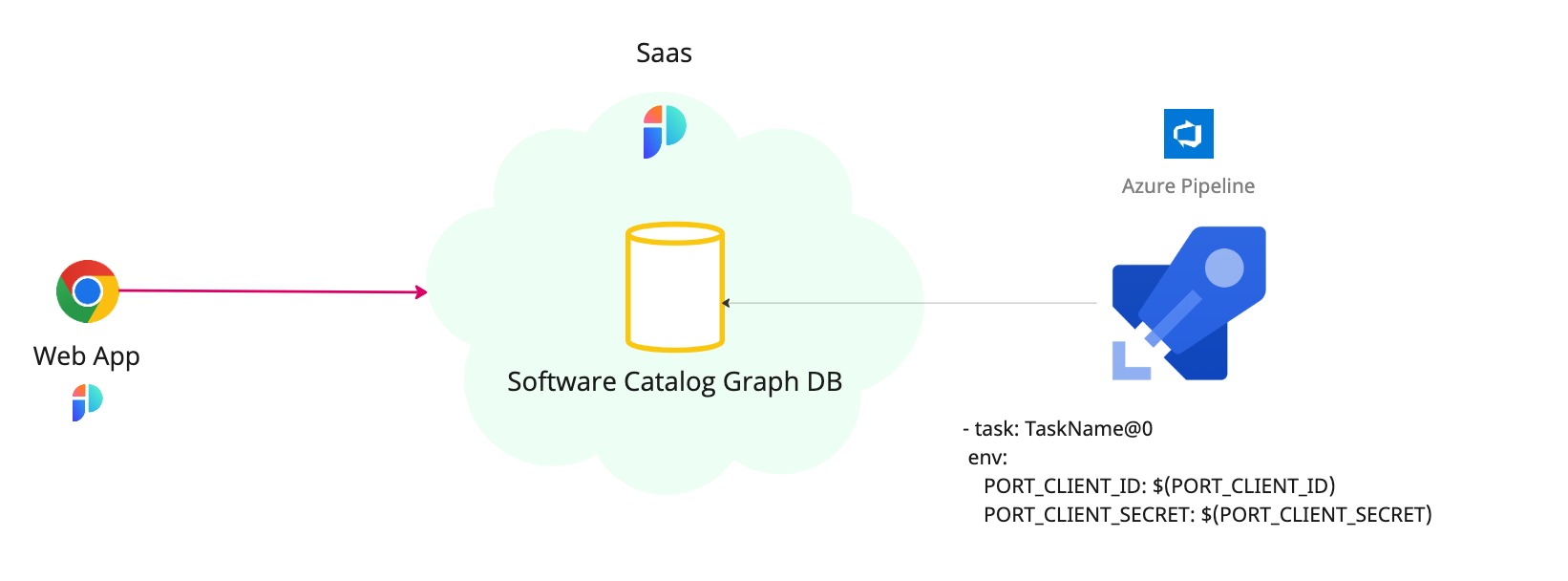Azure Pipelines
使用 Azure Pipelines,可以轻松创建/更新和查询 Port 中的实体。

💡 常见的 Azure Pipelines Usage
例如,Port 的应用程序接口(API)可轻松实现 Port 与 Azure Pipelines 作业的集成:
- 报告正在运行的CI任务的状态;
- 更新软件目录中有关微服务新**构建版本的信息;
- 获取现有实体。
设置
要使用 Azure Pipelines 与 Port 交互,首先需要将define your Port credentials 作为管道的变量。然后,将定义的变量传递给管道脚本,例如 Python:
- task: PythonScript@0
env:
PORT_CLIENT_ID: $(PORT_CLIENT_ID) # The variable name for your Port clientId
PORT_CLIENT_SECRET: $(PORT_CLIENT_SECRET) # The variable name for your Port clientSecret
inputs:
scriptSource: "filePath"
scriptPath: "main.py"
请确保您的 Port 安装中已有Blueprint ,以便创建/更新实体。
使用 Port 的 API
下面是一个示例片段,展示了如何使用 Python 将被用于 Port API 的作业与现有的 Azure 管道集成:
在 Azure Pipelines 中添加以下任务:
Azure pipeline YAML
- script: |
pip install -r port_requirements.txt
- task: PythonScript@0
env:
PORT_CLIENT_ID: $(PORT_CLIENT_ID)
PORT_CLIENT_SECRET: $(PORT_CLIENT_SECRET)
inputs:
scriptSource: "filePath"
scriptPath: "port.py"
在下面的示例中,我们使用了需要安装的 Python 模块。 你可以引用下面的
requirements.txt:port_requirements.txt
requests>=2.28.2
- Create/Update
- Get
在版本库中创建以下 Python 脚本,以创建或更新 Port 实体,作为管道的一部分:
import os
import requests
import json
# These are the credentials passed by the variables of your pipeline to your tasks and in to your env
CLIENT_ID = os.environ['PORT_CLIENT_ID']
CLIENT_SECRET = os.environ['PORT_CLIENT_SECRET']
credentials = {
'clientId': CLIENT_ID,
'clientSecret': CLIENT_SECRET
}
token_response = requests.post(f"{API_URL}/auth/access_token", json=credentials)
access_token = token_response.json()['accessToken']
headers = {
'Authorization': f'Bearer {access_token}'
}
entity_json = {
"identifier": "example-entity",
"properties": {
"myStringProp": "My value",
"myNumberProp": 1,
"myBooleanProp": true,
"myArrayProp": ["myVal1", "myVal2"],
"myObjectProp": {"myKey": "myVal", "myExtraKey": "myExtraVal"}
}
}
# request url : {API_URL}/blueprints/<blueprint_id>/entities
create_response = requests.post(f'{API_URL}/blueprints/test-blueprint/entities?upsert=true', json=entity_json, headers=headers)
print(json.dumps(get_response.json(), indent=4))
在版本库中创建以下 Python 脚本,以获取 Port 实体作为管道的一部分:
import os
import requests
import json
# These are the credentials passed by the variables of your pipeline to your tasks and in to your env
CLIENT_ID = os.environ['PORT_CLIENT_ID']
CLIENT_SECRET = os.environ['PORT_CLIENT_SECRET']
credentials = {
'clientId': CLIENT_ID,
'clientSecret': CLIENT_SECRET
}
token_response = requests.post(f"{API_URL}/auth/access_token", json=credentials)
access_token = token_response.json()['accessToken']
headers = {
'Authorization': f'Bearer {access_token}'
}
# request url : {API_URL}/blueprints/<blueprint_id>/entities/<entity_id>
get_response = requests.get(f"{API_URL}/blueprints/test-blueprint/entities/test-entity", headers=headers)
print(json.dumps(get_response.json(), indent=4))
示例
有关使用 Azure Pipelines 处理 Port 的实用示例,请引用examples 页面。